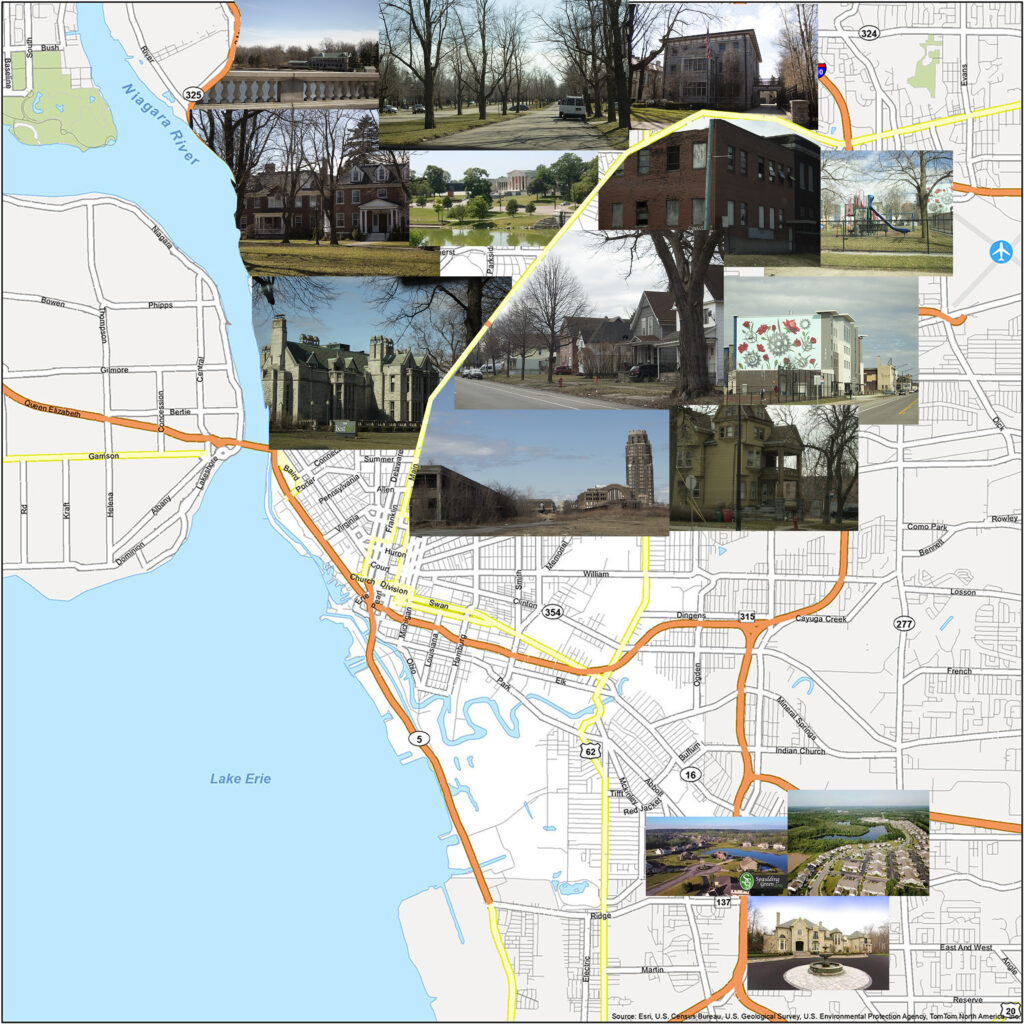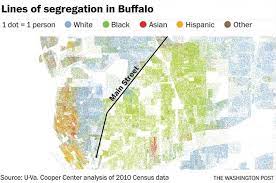One day while driving my brother and a few of his friends to our house, his friend Jerry, a black 16-year-old from Buffalo who has been to our house countless times since he was 12, looked at me and said “I feel like I’m not allowed to be here. No one looks like me…Shit is scary.” This was a heart wrenching sentiment to hear from one of my brother’s closest friends—because of the truth behind it. I live in a predominantly white suburb thirty minutes south of Buffalo, NY called East Aurora, East Aurora is 96.9% white (Census Bureau, 2021). I had known my neighborhood was overwhelmingly white, however hearing such a direct statement made me more aware of the effects of segregation in Buffalo.
How We Got Here: Discrimination and the Erie Canal
Buffalo, New York is one of the most racially segregated cities in America, a trend that began with the completion of the Erie Canal in 1825 (Richardson, 2014). Buffalo grew rapidly as the canal provided many job opportunities, but they were reserved for white immigrants. African Americans were pushed into the service industry, where they were forced to compete for jobs and where employment depended largely on an individual’s proximity to downtown Buffalo. This issue forced most African Americans to seek housing on the East Side of Buffalo (Richardson, 2014).
Racial Zoning Laws, Restrictive Covenants and White Flight
Racial zoning laws prohibited mixed-race neighborhoods and restricted the Black population to the east side of Buffalo. Fortunately, such zoning laws were made illegal in 1914, but they were followed by other methods of forced racial segregation such as restrictive covenants and redlining. Restrictive covenants are clauses in property deeds that prohibit the sale of properties to people of color (Blatto, 2018). Redlining restricted the mobility of Black Americans and appreciation in the value of their homes. Redlining worked to keep people of color concentrated in areas with low incomes and wealth while restrictive covenants ensured that white suburbs remained white. White residents of the City of Buffalo began moving to suburbs in the 1950s because of government subsidized projects such as highways, water systems and sewer systems. Buffalo’s suburban population was almost exclusively white due to exclusionary zoning practices and redlining. Jobs in education and government as well as the service-sector followed white flight into Buffalo’s suburbs.


On-going Effects of Economic and Racial Segregation in Buffalo, NY: Economic Inequality
As a result of redlining and restrictive covenants, in 2018 white people made up 73% of Erie County’s population and only 45% of the City of Buffalo. This rate continues to drop as white families and individuals keep moving out of the city. At 28.3%, the poverty rate in Buffalo is almost three times the national rate of 11.4% (U.S. Census Bureau, 2020). The East Side has an unemployment rate of 16% compared to 7% in adjacent neighborhoods (Richardson 2014). The median household income in Buffalo, NY is $39,677. By contrast, the median household income for the United States is $67,521. More specifically, Amherst, a large suburb of Buffalo, has a median household income of $72,459 and East Aurora (the town I live in) has a median income of $73,770 (U.S. Census Bureau).
Educational Inequalities
The concentration of poverty in the city center has resulted in inequalities of education standards. For example, most public schools in Buffalo are underfunded and do not offer adequate education (Richardson 2014). The public-school minority enrollment in Buffalo is 80% and 60% of students are economically disadvantaged (US News). In the East Side of Buffalo, school performance rates are lower, drug and alcohol addiction rates are higher, and depression and anxiety rates are higher than in surrounding areas (Richardson, 2014).
In my town—East Aurora—the public high school is one of the best in the area and is ranked 104th in New York State. East Aurora Union Free School District has a math proficiency score of 96 and a reading proficiency score of 99. Conversely, the Buffalo City School District, which has a math proficiency score of 52 and a reading proficiency score of 74 (U.S. News Education, 2021).
Limited Public Transportation
Despite requests for more reliable public transportation, public transport is not a priority in Buffalo. There is little to no public transportation outside of the city, which affects housing and employment as well as education opportunities and keeps low-income people in the city center. Today, the inequality between neighborhoods is growing as white, upper-class families are still move out of Buffalo and into surrounding suburbs.

Restoring the East Side
Andrew Cuomo announced his plan for the— “Buffalo Billion”—to invest 1 billion dollars into Buffalo’s economy in 2012. A revised version of the “Buffalo Billion” was, released in 2019 and includes a five-year plan to restore Buffalo’s East Side with $65 million. This money is being used to encourage private development by improving infrastructure and strengthening community relationships. The city will also offer training and grants for local entrepreneurs and business owners. A portion of the money will be used to restore old buildings, streets, and to improve parks on the east side (Sommer, 2020). This program may be successful in lessoning economic inequality in Buffalo; however, it fails to address racial segregation in Buffalo.
References
Anon. n.d. “Buffalo City School District – U.S. News Education.” Retrieved May 1, 2022 (https://www.usnews.com/education/k12/new-york/districts/buffalo-city-school-district-112767).
Anon. n.d. “New York School Districts | US News Best High Schools.” U.S. News. Retrieved May 1, 2022 (https://www.usnews.com/education/best-high-schools/new-york/districts).
Blatto, Anna. 2018. “A City Divided: A Brief History of Segregation in Buffalo.” Partnership for the Public Good.
Richardson, William Jamal, Lori Glantz, and Robert M. Adelman. 2014. “‘Ain’t Nothin’ Here in Buffalo’: Residents’ Perceptions about Living in a Racially Isolated, High-Poverty Neighborhood.” Journal of Children and Poverty20(2):73–90.
Sommer, Mark. 2022. “Bolstered by $65m Plan for Revitalization, East Side Ready for ‘Catalytic Moment’.” Buffalo News. Retrieved May 1, 2022 (https://buffalonews.com/news/local/bolstered-by-65m-plan-for-revitalization-east-side-ready-for-catalytic-moment/article_45168985-bf3c-5d3b-b5db-9e1255175351.html).